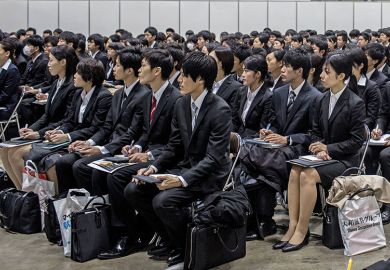Japan’s determination to preserve its universities is putting pressure on the private network that teaches 80 per cent of the country’s students.
Shinzo Abe’s administration is capping enrolments at private universities in Tokyo to prevent regional institutions – which are struggling for survival as Japan’s population declines – from losing enrolments to the capital.
The government has abandoned its previously lenient treatment of universities that exceeded mandated admissions caps, with institutions that over-enrol now losing public subsidies. Tokyo universities wishing to establish new programmes, or expand existing ones, must compensate by reducing admissions elsewhere.
Christopher Pokarier, professor of business and governance at Tokyo’s Waseda University, said that Mr Abe was resurrecting a policy attempted unsuccessfully in the 1970s and 1980s, when his predecessors had tried to nurture the regions by shackling university growth in Tokyo and Kyoto.
He said that this was possible in Japan, where the government regulates student places but not prices. “There’s a ministry-led attempt to gradually downscale Japanese higher education because it’s massively over-supplied,” Professor Pokarier said.
“Effectively, the government is spilling the demand out to the less popular universities so a whole bunch of them don’t go bankrupt.”
Professor Pokarier said that strict enforcement of admissions caps was costing Tokyo universities up to 30 per cent of their tuition revenue. Prestigious ones such as Waseda are able to compensate by raising their fees, and parents tolerate this because it made their children’s universities – typically their own alma maters – appear more exclusive.
But “mid-tier” institutions are struggling because they cater to families that cannot afford higher fees. Meanwhile, students unable to gain access to top-shelf universities are displacing people from lower-ranked ones.
Internationalisation expert Hiroshi Ota said that Japan has 50 per cent more universities than in 1992, even though school-leaver numbers had declined by two-fifths in the past two decades. He said that 36 per cent of private universities do not have enough students, triggering “financial difficulties” that diminish their quality.
He said that regional universities could strengthen their positions by attracting more good international students – partly because this would boost enrolments, but mainly because it would cultivate more competitive practices.
“Funding mechanisms are not the solution,” said Professor Ota, director of the Global Education Programme at Hitotsubashi University in Tokyo. “What is needed is more deregulation, and expansion of university autonomy leading to institutional openness and flexibility.”
Annette Bradford, an associate professor at Meiji University in Tokyo, said that some universities face inevitable closure. “I don’t see what’s wrong with that,” she said. “If we’ve got fewer people, we don’t need those universities. We’re probably accepting too many people to universities because it’s easier to get in.”
But sources have said that institutional closures were politically unacceptable and “anathema” to Japanese bureaucrats. Peter McCagg, vice-president of academic affairs at Akita International University in northern Honshu, said that Japan was “loathe to pull the plug on institutions”.
Some Tokyo academics blame the freeze on admissions for their static salaries, which have “flatlined” for years or even been cut.
Professor Pokarier said that the freeze was expected to force struggling universities to “rigour up” by developing more market-oriented programmes. “But when you’ve got a whole bunch of tenured staff, getting them to shift into different disciplinary areas is difficult,” he said.
Register to continue
Why register?
- Registration is free and only takes a moment
- Once registered, you can read 3 articles a month
- Sign up for our newsletter
Subscribe
Or subscribe for unlimited access to:
- Unlimited access to news, views, insights & reviews
- Digital editions
- Digital access to THE’s university and college rankings analysis
Already registered or a current subscriber?










